Pherkad, Gamma Ursae Minoris (γ UMi), is a white giant or bright giant star located in the northern constellation Ursa Minor. With an apparent magnitude of 3.05, it is the third brightest star in the constellation, after Polaris and Kochab. Pherkad lies at a distance of 487 light years from Earth. It is one of the seven stars that form the Little Dipper, an asterism that can be used to find true north.
Star type
Pherkad is a single star of the spectral type A2 III, indicating a white giant. Some sources give the stellar classification A2 II-III, placing the star between a giant and bright giant, while measurements of the star’s spectrum have yielded the spectral type A3 Iab, indicating an intermediate luminosity supergiant.
Pherkad has a mass of about 4.8 solar masses and a radius 15 times that of the Sun. With an effective temperature of 8,280 K, it is about 1,100 times more luminous than the Sun. The star is a very fast spinner, with a projected rotational velocity of 180 km/s. Its estimated age is just over 100 million years.
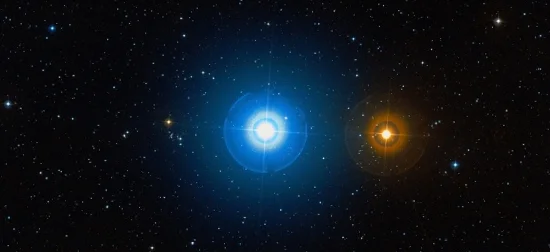
Pherkad (Gamma Ursae Minoris), image: Wikisky
Pherkad is not massive enough to end its life as a supernova. Instead, when it reaches the end of its life, it will cast off its outer layers into space and gradually fade away as a massive white dwarf.
Pherkad is a variable star. Its brightness has been reported to vary by a few tenths of magnitude over a period of 3.43 hours. The General Catalog of Variable Stars lists the star as a Delta Scuti variable. Delta Scuti stars are pulsating variables whose brightness varies as they contract and expand. Seginus in the constellation Boötes and Epsilon Cephei in Cepheus are among the brighter examples of this class.
Pherkad has also been classified as a shell star, a fast-spinning star with a circumstellar disk of gas around the equator. The disk of gas expelled from the star due to its fast rotation may also be the cause of the variations in magnitude.
Facts
Pherkad is one of the seven relatively bright stars in Ursa Minor that form the Little Dipper. Pherkad forms the Dipper’s bowl with Kochab (Beta Ursae Minoris), Zeta Ursae Minoris and Eta Ursae Minoris, while Polaris (Alpha Ursae Minoris), Yildun (Delta Ursae Minoris) and Epsilon Ursae Minoris form the Dipper’s handle.
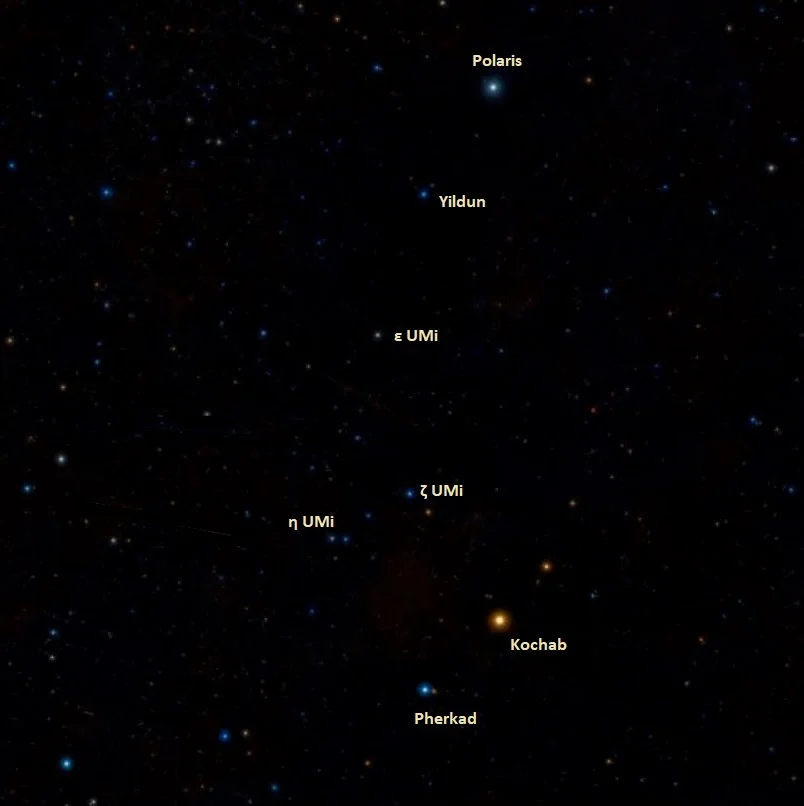
Little Dipper, image: Wikisky
The Little Dipper is smaller and considerably fainter than the Big Dipper in the constellation Ursa Major. Unlike its big brother, the asterism is not easy to spot from light-polluted areas because its middle four stars are fainter than magnitude 4.00. Only three stars are bright enough to be visible from cities: Polaris, Kochab, and Pherkad.
Pherkad and its brighter neighbour Kochab are known as Guardians of the Pole. The two stars circle the north celestial pole and Polaris, the nearest bright star to the pole. While other stars appear to move across the sky, Polaris always appears in the same place, and the rest of the Little Dipper appears to circle around it.
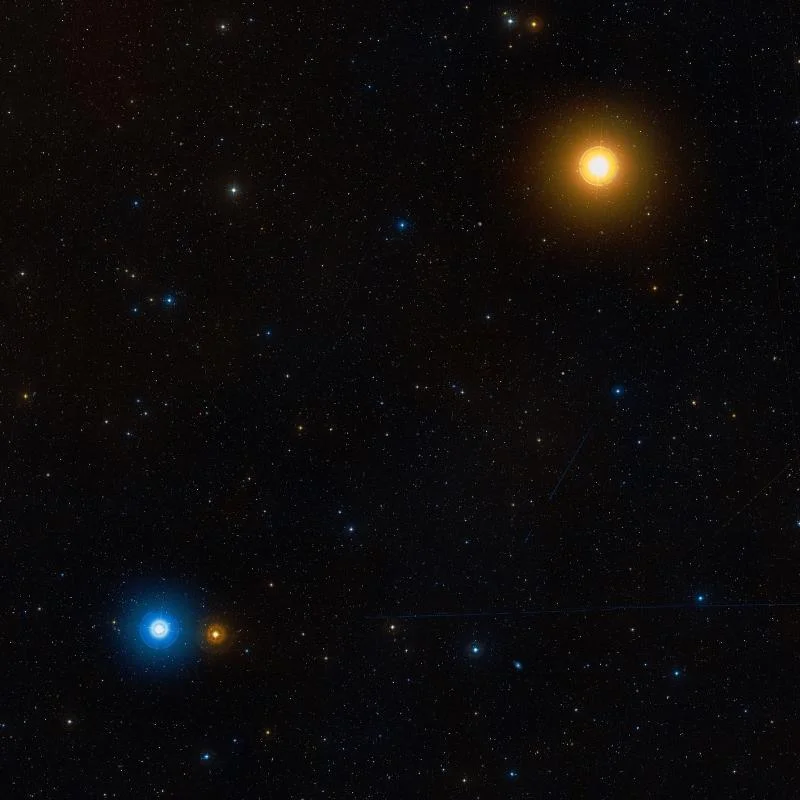
Pherkad and Kochab, image: Wikisky
Kochab and Pherkad were once used in navigation as markers of true north. Kochab was the North Star before Polaris took over in the early Middle Ages, but it was never as close to the pole as Polaris is today. Kochab shared the title with Kappa Draconis in Draco constellation and was also used in conjunction with Pherkad after 2000 BCE.
Pherkad Minor
The orange giant 11 Ursae Minoris appears in the same field of view as Pherkad and has traditionally been known as Pherkad Minor, while Gamma Ursae Minoris has been called Pherkad Major. At a distance of 410 light years, the orange star is much closer to us and is not physically associated with Pherkad. With an apparent magnitude of 5.15, it is visible next to its brighter neighbour in exceptionally good conditions. The star hosts a superjovian exoplanet, 11 Ursae Minoris b, with a mass at least 10.5 times that of Jupiter. The planet may in fact be a brown dwarf. It was discovered on August 12, 2009.
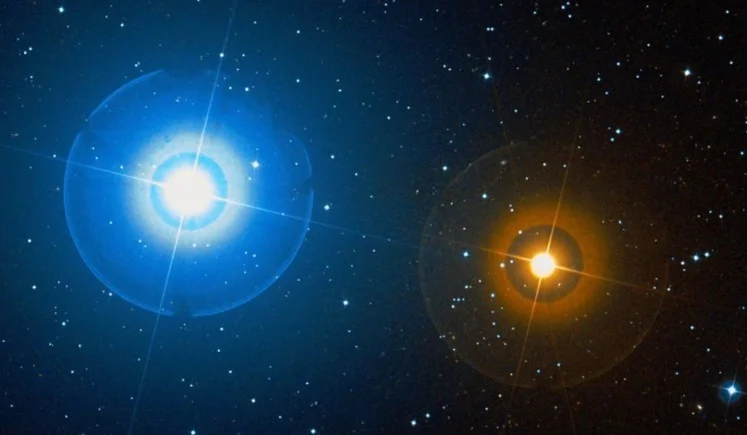
Pherkad and Pherkad Minor (11 Ursae Minoris), image: Wikisky
Name
The name Pherkad (pronunciation: /ˈfɜːrkæd/) is derived from the Arabic farqad, meaning “calf.” It comes from the phrase aḫfa al farkadayn, meaning “the dim one of the two calves.” The brighter of the two calves is Kochab. The name Ahfa al Farkadain has traditionally been used for the fainter Zeta Ursae Minoris.
The name Pherkad was approved by the International Astronomical Union’s (IAU) Working Group on Star Names (WGSN) on August 21, 2016.
The Chinese know Pherkad as 北極一 (Běi Jí yī), the First Star of North Pole. Pherkad is part of the Chinese North Pole asterism, also formed by Kochab, 5 Ursae Minoris, 4 Ursae Minoris, and Σ 1694 (Struve 1694) in the constellation Camelopardalis. In Chinese astronomy, the North Pole asterism is one of the mansions of the Purple Forbidden Enclosure, which represents the imperial palace. Pherkad represents the Crown Prince and Kochab symbolizes the Emperor.
Location
Pherkad is easy to find on a clear, dark night because it is part of the Little Dipper, one of the most recognizable asterisms in the northern sky. Pherkad and its brighter neighbour Kochab form the end of the Dipper’s bowl.
The Little Dipper can be found using the stars of the bigger and brighter Big Dipper. Merak and Dubhe, the outer stars of the Big Dipper’s bowl, are known as Pointer Stars because they point the way to Polaris, the North Star, which marks the tip of the Little Dipper’s handle. A line extended from Merak through Dubhe leads to Polaris. Pherkad is the fainter of the two outer stars of the Little Dipper’s bowl. It has a faint visual companion, 11 Ursae Minoris, and is almost a full magnitude fainter than Kochab.
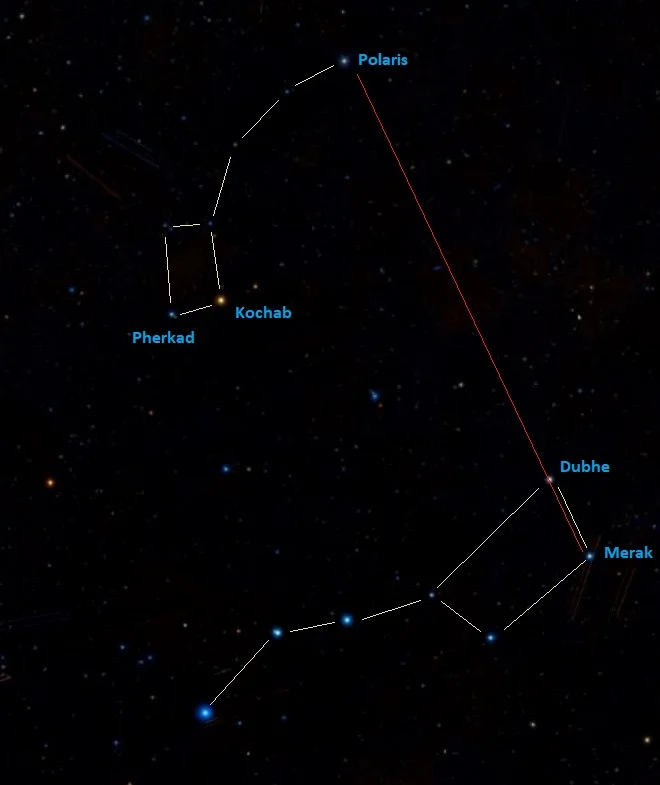
The Little Dipper and Big Dipper, image: Wikisky
In less-than-ideal conditions, when the inner stars of the Little Dipper are not visible, Pherkad and Kochab can be identified as the two relatively bright stars north of the Big Dipper’s handle. The imaginary line connecting Kochab and Pherkad is roughly parallel to the line connecting Mizar and Alioth, the inner stars of the Big Dipper’s handle.
Constellation
Pherkad is located in the constellation Ursa Minor, the Little Bear. Like the larger bear constellation (Ursa Major), Ursa Minor is one of the 48 Greek constellations, first catalogued by the astronomer Claudius Ptolemy of Alexandria in his Almagest in the 2nd century CE. The constellation was introduced to the Greeks (or possibly created) by the 6th century BCE Greek philosopher Thales of Miletus, who found its stars useful in navigation.
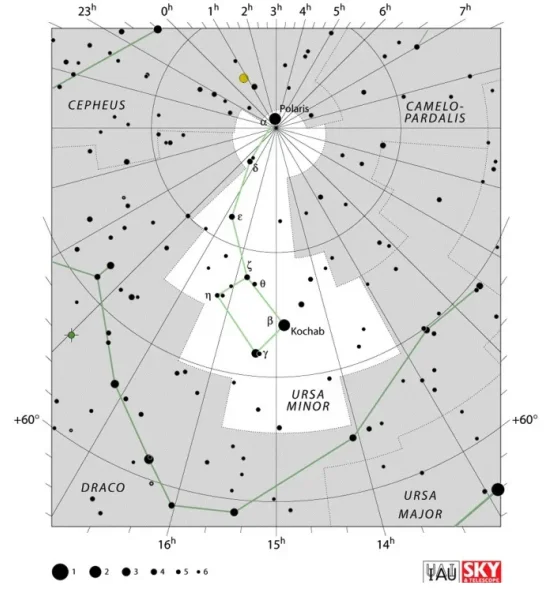
Ursa Minor constellation map by IAU and Sky&Telescope magazine
Ursa Minor is relatively small. It is the 56th constellation in size, occupying an area of 256 square degrees. It is the northernmost of the 88 constellations and home to the north celestial pole. For northern observers, the constellation is circumpolar, i.e. it never falls below the horizon and is visible year-round. For most southern observers, Ursa Minor never rises above the horizon and can only be seen from southern latitudes close to the equator.
Ursa Minor is best known for the Little Dipper asterism and for Polaris, the nearest visible star to the north celestial pole. The constellation contains several other notable stars, including the orange giants Kochab and Theta Ursae Minoris, the semiregular variable red giants Lambda Ursae Minoris, R Ursae Minoris and RR Ursae Minoris, the variable carbon star Z Ursae Minoris, and the spectroscopic binary system Epsilon Ursae Minoris. Ursa Minor is also home to H1504+65, the hottest white dwarf known (200,000 K), and to 1RXS J141256.0+792204, one of the nearest neutron stars to Earth, nicknamed Calvera after the villain in The Magnificent Seven.
Notable deep sky objects in Ursa Minor include Polarissima Borealis (NGC 3172), the nearest NGC object to the north celestial pole, the barred spiral galaxy NGC 6217, the supergiant elliptical radio galaxy NGC 6251, and the Ursa Minor Dwarf (PGC 54074), a relatively bright satellite galaxy of the Milky Way.
The best time of year to observe the stars and deep sky objects of Ursa Minor is during the month of June. The entire constellation can be seen from locations between the latitudes 90° N and 10° S.
The 10 brightest stars in Ursa Minor are Polaris (Alpha UMi, mag. 1.86 – 2.13), Kochab (Beta UMi, mag. 2.08), Pherkad (Gamma UMi, mag. 3.05), Epsilon Ursae Minoris (mag. 4.19), 5 Ursae Minoris (mag. 4.253), Zeta Ursae Minoris (mag. 4.32), Yildun (Delta UMi, mag. 4.36), RR Ursae Minoris (mag. 4.44 – 4.85), 4 Ursae Minoris (mag. 4.80), and Eta Ursae Minoris (mag. 4.95).
Pherkad – Gamma Ursae Minoris
| Spectral class | A2 III |
| Variable type | Delta Scuti (suspected) or shell star |
| U-B colour index | +0.08 |
| B-V colour index | +0.09 |
| Apparent magnitude | 3.05 |
| Absolute magnitude | -2.84 |
| Distance | 487 ± 8 light years (149 ± 2 parsecs) |
| Parallax | 6.70 ± 0.11 mas |
| Radial velocity | -3.90 ± 0.6 km/s |
| Proper motion | RA: -17.73 ± 0.13 mas/yr |
| Dec.: +17.90 ± 0.11 mas/yr | |
| Mass | 4.8 M☉ |
| Luminosity | 1,100 L☉ |
| Radius | 15 R☉ |
| Temperature | 8,280 ± 240 K |
| Rotational velocity | 180 km/s |
| Surface gravity | 2.53 cgs |
| Constellation | Ursa Minor |
| Right ascension | 15h 20m 43.7160391s |
| Declination | +71° 50′ 02.459561″ |
| Names and designations | Pherkad, Gamma Ursae Minoris, γ UMi, 13 Ursae Minoris, HD 137422, HR 5735, HIP 75097, FK5 569, BD+72°679, SAO 8220, PPM 8887, GC 20692, GCRV 8907, GSC 04414-02314, PLX 3484.00, AG+72 399, IRAS 15207+7200, 2MASS J15204375+7150024, JP11 2602, UBV 13257, TYC 4414-2314-1, Gaia DR2 1696877570752028288 |